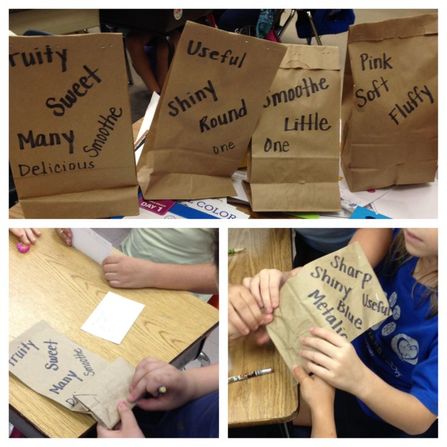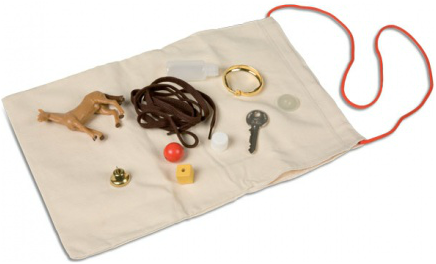Text Box/bag activity
|
According to page 59 of Dr. Mimi Miller and Nancy Veatch in their 2011 book entitled Literacy in Context (LinC): Choosing Instructional Strategies to Teach Reading in Content Areas for Students Grades 5-12, "The purpose of the Text Box/Bag Activity is to help readers build background knowledge about a topic." With the Text Box/Bag Activity, students see and hold realia—real objects that are going to be featured in the text. These items can be stored in a central place in the room so that students have access to them. This activity can be used as a writing activity by having students write their descriptions of what the item is and how it is supposed to be used. They can even write about how they came up with their ideas.
According to Ellen Siebers of the Mathers Museum of World Cultures, "Teaching with objects and photographs creates a direct, sensory connection between learners and their subjects that results in new levels of interest and attention. Teaching with objects also creates students with higher levels of visual literacy." Common Core Standard
CCSS.ELA-LITERACY.RL.4.1 Refer to details and examples in a text when explaining what the text says explicitly and when drawing inferences from the text. |
Video Examples
|
In this lesson the students are actively engaged in a game that reinforces their understanding of the term "inference." While the teacher pulls an unknown object from a the bag, students are challenged to infer the function of each based on the "tool's clues." As inferences are made, students are asked to explain the rationale for their thinking.
|
In this lesson students discuss what their item has to do with population. In this activity students think-pair-share in this lesson to talk about dense and sparse population. The visual, physical, and discussion aspect of this lesson are strong.
|
Miller and Veatch's 2011 Guide to:
Creating a Text-Box Bag Activity
1. Identify an appropriately leveled piece of text that covers the concept needing to be taught.
2. In preparation, identify 5 to 7 concepts within the text that are both important to the meaning of the text and can be represented by an object.
3. Gather objects representing these words or concepts, and place them into a box or bag.
4. When the lesson begins, give a brief introduction about the topic to the class—but don’t give too much away. Pull an object out of the box, and with students, think aloud about the object and its possible connection to the text.
5. Continue to pull objects, thinking aloud about them.
6. As students read the text, ask them to locate each of these concepts and/or words within the text and highlight or underline them.
7. At the conclusion of the reading, show each of the items, and review how they connected to the text.
2. In preparation, identify 5 to 7 concepts within the text that are both important to the meaning of the text and can be represented by an object.
3. Gather objects representing these words or concepts, and place them into a box or bag.
4. When the lesson begins, give a brief introduction about the topic to the class—but don’t give too much away. Pull an object out of the box, and with students, think aloud about the object and its possible connection to the text.
5. Continue to pull objects, thinking aloud about them.
6. As students read the text, ask them to locate each of these concepts and/or words within the text and highlight or underline them.
7. At the conclusion of the reading, show each of the items, and review how they connected to the text.
Examples
|
MS Science Lesson
- Descriptive Observations and Inferences 7th Grade Paper Bag Book Report 4th Grade Science Lesson - Inferences and Opinions Using objects from a Field Trip |
Resources
Education UK. (2012) Using props to teach geography at secondary school level. Retrieved from https://www.youtube.com/watch?v=bCCzzsXWXPw
Kantim. (2011). Precision Teaching: Inference Game. Retrieved from https://www.youtube.com/watch?v=z-Vu_CqyEpo
Miller, M., & Veatch, N. (2011). Literacy in context (LinC): Choosing instructional strategies to teach reading in content areas for students grades 5-12. Boston: Pearson.
Scholastic. (2015). Mystery bags to develop observation and inference skills. Retrieved from http://video.scholastic.com/services/player/bcpid2727792767001?bckey=AQ~~,AAAAAFv844g~,BASb5BU03X-DrGv5AhG6m2DlgA4HQAmE&bctid=3023031200001
Seibers, Ellen. (2012). Teaching with Objects and Photographs Supporting and Enhancing Your Curriculum. Retrieved from http://www.indiana.edu/~mathers/Tops.pdf
Education UK. (2012) Using props to teach geography at secondary school level. Retrieved from https://www.youtube.com/watch?v=bCCzzsXWXPw
Kantim. (2011). Precision Teaching: Inference Game. Retrieved from https://www.youtube.com/watch?v=z-Vu_CqyEpo
Miller, M., & Veatch, N. (2011). Literacy in context (LinC): Choosing instructional strategies to teach reading in content areas for students grades 5-12. Boston: Pearson.
Scholastic. (2015). Mystery bags to develop observation and inference skills. Retrieved from http://video.scholastic.com/services/player/bcpid2727792767001?bckey=AQ~~,AAAAAFv844g~,BASb5BU03X-DrGv5AhG6m2DlgA4HQAmE&bctid=3023031200001
Seibers, Ellen. (2012). Teaching with Objects and Photographs Supporting and Enhancing Your Curriculum. Retrieved from http://www.indiana.edu/~mathers/Tops.pdf


